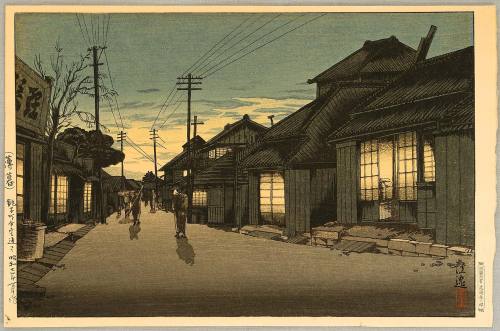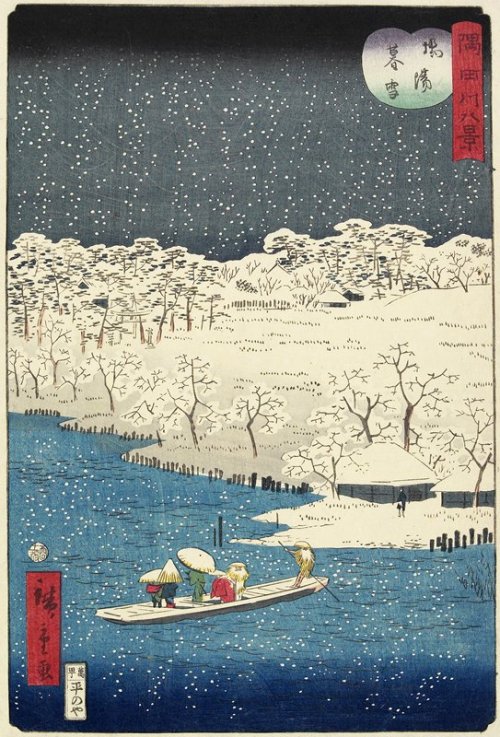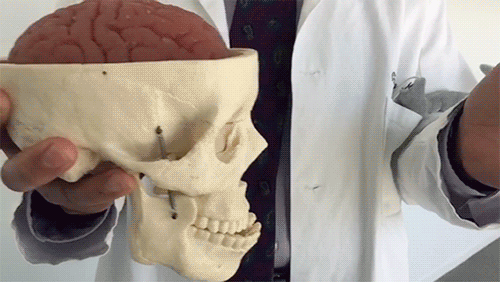Ritasakano - Outubros
More Posts from Ritasakano and Others
Delicada sempre.


Textile sample. Japanese, Late Edo or early Meiji era, 19th century. Textile sample with design of carnations and lily-like flowers in white, reddish-orange, dark blue, yellow, grays, and light yellow browns on a blue ground, created by the yûzen process. Provenance: William Sturgis Bigelow Collection; gift of William Sturgis Bigelow to the MFA in August, 1898. MFA






What is it about this twilight hour? Even the sound of a barely perceptible breeze pierces the heart. (Ono no Komachi, c. 825 – c. 900, Japanese poet of the early Heian period).
It’s no longer day but night hasn’t come yet either. One by one, the voices that fill the hours of the day with their incessant noise fade until the silence is almost complete. Some aspects of the colours stay concealed in daylight, but now comes the moment for them to appear. The evening light reduces every superfluous detail, every unnecessary shape; it is at the same time the absolute truth and the most beautiful lie.
Today let’s wander in evening landscapes (top to bottom, left to right): Evening at Ushibori, by Kawase Hasui, 1930 [source]; Evening Glow at Choshi, by Tsuchiya Koitsu, 1932 [source]; Dusk at Itako, by Kawase Hasui, 1932 [source]; Fishing Boats at Sea, by Ohara Koson, c. 1900 [source]; Evening at Minano in Chichibu, by Kawase Hasui, 1946 [source]; Evening Snow at Hashiba, by Utagawa Hiroshige II 1861 [source].

This is your brain experiencing a concussion
It may look like this model brain is made of Jell-O, but it’s the same consistency as a real brain.
As Dr. Christopher Giza from UCLA demonstrates, the brain is made of soft tissue and floats in fluid inside of the skull. When the skull moves quickly, the brain can jostle around a lot, which can lead to neurological symptoms.
“Most concussions are recoverable,” Giza said.
But concussions can be difficult to identify and some people suffer more serious symptoms, particularly after multiple concussions.
Lab studies have shown a “window of vulnerability” after a first concussion, Giza said. Concussed athletes are three to six times more likely to get another concussion. If they rush back to play, their reflexes, reaction time and thinking may be slower, putting them at risk of a second concussion and longer recovery period.
Six things parents and athletes need to know about concussions.
A sutileza dos detalhes.










Utagawa Kuniyoshi. The Sixty-nine Post Stations of Kisokaidô Road. 1852.
Katsushika Hokusai (葛飾北斎?, outubro ou novembro de 1760 – 18 de abril de 1849) foi um artista japonês, pintor de estilo ukiyo-e e gravurista do período Edo. Em sua época, era um dos principais especialistas em pintura chinesa do Japão.[1] Nascido em Edo (atual Tóquio), Hokusai é melhor conhecido como autor da série de xilogravuras Trinta e seis vistas do monte Fuji (富嶽三十六景, Fugaku Sanjūroku-kei?, c. 1831) que inclui sua pintura icônica e internacionalmente conhecida, A Grande Onda de Kanagawa, criada durante a década de 1820.










Katsushika Hokusai
Lentes gravitacionais.
What is Gravitational Lensing?
A gravitational lens is a distribution of matter (such as a cluster of galaxies) between a distant light source and an observer, that is capable of bending the light from the source as the light travels towards the observer. This effect is known as gravitational lensing, and the amount of bending is one of the predictions of Albert Einstein’s general theory of relativity.

This illustration shows how gravitational lensing works. The gravity of a large galaxy cluster is so strong, it bends, brightens and distorts the light of distant galaxies behind it. The scale has been greatly exaggerated; in reality, the distant galaxy is much further away and much smaller. Credit: NASA, ESA, L. Calcada
There are three classes of gravitational lensing:
1° Strong lensing: where there are easily visible distortions such as the formation of Einstein rings, arcs, and multiple images.

Einstein ring. credit: NASA/ESA&Hubble
2° Weak lensing: where the distortions of background sources are much smaller and can only be detected by analyzing large numbers of sources in a statistical way to find coherent distortions of only a few percent. The lensing shows up statistically as a preferred stretching of the background objects perpendicular to the direction to the centre of the lens. By measuring the shapes and orientations of large numbers of distant galaxies, their orientations can be averaged to measure the shear of the lensing field in any region. This, in turn, can be used to reconstruct the mass distribution in the area: in particular, the background distribution of dark matter can be reconstructed. Since galaxies are intrinsically elliptical and the weak gravitational lensing signal is small, a very large number of galaxies must be used in these surveys.

The effects of foreground galaxy cluster mass on background galaxy shapes. The upper left panel shows (projected onto the plane of the sky) the shapes of cluster members (in yellow) and background galaxies (in white), ignoring the effects of weak lensing. The lower right panel shows this same scenario, but includes the effects of lensing. The middle panel shows a 3-d representation of the positions of cluster and source galaxies, relative to the observer. Note that the background galaxies appear stretched tangentially around the cluster.
3° Microlensing: where no distortion in shape can be seen but the amount of light received from a background object changes in time. The lensing object may be stars in the Milky Way in one typical case, with the background source being stars in a remote galaxy, or, in another case, an even more distant quasar. The effect is small, such that (in the case of strong lensing) even a galaxy with a mass more than 100 billion times that of the Sun will produce multiple images separated by only a few arcseconds. Galaxy clusters can produce separations of several arcminutes. In both cases the galaxies and sources are quite distant, many hundreds of megaparsecs away from our Galaxy.
Gravitational lenses act equally on all kinds of electromagnetic radiation, not just visible light. Weak lensing effects are being studied for the cosmic microwave background as well as galaxy surveys. Strong lenses have been observed in radio and x-ray regimes as well. If a strong lens produces multiple images, there will be a relative time delay between two paths: that is, in one image the lensed object will be observed before the other image.

As an exoplanet passes in front of a more distant star, its gravity causes the trajectory of the starlight to bend, and in some cases results in a brief brightening of the background star as seen by a telescope. The artistic concept illustrates this effect. This phenomenon of gravitational microlensing enables scientists to search for exoplanets that are too distant and dark to detect any other way.Credits: NASA Ames/JPL-Caltech/T. Pyle
Explanation in terms of space–time curvature

Simulated gravitational lensing by black hole by: Earther
In general relativity, light follows the curvature of spacetime, hence when light passes around a massive object, it is bent. This means that the light from an object on the other side will be bent towards an observer’s eye, just like an ordinary lens. In General Relativity the speed of light depends on the gravitational potential (aka the metric) and this bending can be viewed as a consequence of the light traveling along a gradient in light speed. Light rays are the boundary between the future, the spacelike, and the past regions. The gravitational attraction can be viewed as the motion of undisturbed objects in a background curved geometry or alternatively as the response of objects to a force in a flat geometry.

A galaxy perfectly aligned with a supernova (supernova PS1-10afx) acts as a cosmic magnifying glass, making it appear 100 billion times more dazzling than our Sun. Image credit: Anupreeta More/Kavli IPMU.
To learn more, click here.
My brother and I saw this precious little rat snake watching everyone gardening in my grandparents’ yard. How could anyone hate this sweet curious face? I was cooing at him for like 20 minutes ♥️

The polluted brain
Some of the health risks of inhaling fine and ultrafine pollutant particles are well-established, such as asthma, lung cancer, and, most recently, heart disease. But a growing body of evidence suggests that such exposure can also harm the brain, accelerating cognitive aging, and may even increase risk of Alzheimer’s disease and other forms of dementia.
by Emily Underwood
for Science
brought to you by Graphic Services for Science and Graphic Biology